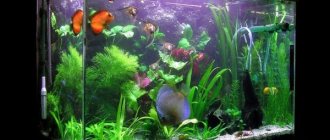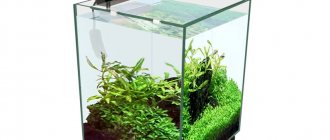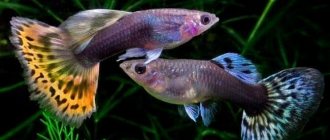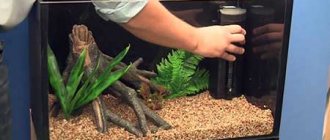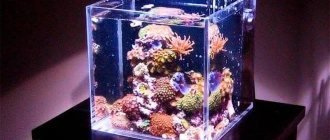Many novice aquarists, when choosing their first aquarium, pay attention to medium-sized containers. A 60 liter aquarium falls into this category. A tank of this size does not take up much space and is easy to maintain. At the same time, you can put more fish in it than in a nano aquarium. In addition, in such an artificial pond you can create a beautiful design that will fit well with the interior of the room.
Choosing an aquarium
The dimensions of a 60 liter aquarium can vary and depend on its configuration. There are containers of various shapes on sale: rectangular, square, round, hexagonal, trapezoidal, panoramic. The most convenient to maintain and most comfortable for fish are rectangular, horizontally oriented models (length - 500 mm, width - 320 mm, height - 400 mm). They are easy to install the necessary equipment and create an interesting design; In addition, such tanks look good in almost any interior. It is recommended to place the aquarium on a special stand; it will not only be able to withstand its weight, but will also help hide the wires trailing from the equipment.
Volume in liters
On the shelves of pet stores there is a wide range of aquariums, including round ones, of different sizes: from 5 to 40-50 or more liters. A round 5 liter aquarium is essentially a large glass jar, which will become not a comfortable home, but a prison for the fish. It is almost impossible to equip it with even the minimum necessary equipment - a filter and a compressor. A five-liter container can only be used for depositing fry.
A round aquarium of 20 liters or more is already a suitable option for keeping fish. In such a volume, you can install enough equipment, house several fish and make their existence comfortable and as safe as possible for health.
Equipment
To ensure that the environment inside the artificial reservoir is comfortable for all its inhabitants, a 60-liter aquarium will need to be equipped with the necessary equipment. Install in the tank:
- Filter. Can be internal, external, canister or bottom. Must have a capacity of 60 l/h. The filter ensures water purification from contaminants and mixing.
- Compressor. This is a device for saturating water with oxygen. Necessary when keeping a large number of hydrobionts.
- Heater and thermometer to control water temperature.
- Lamps and lamps for aquarium lighting. The lamps can be fluorescent (for a 60-liter tank you will need 2 pieces with a power of 10-11 W or 1 piece with a power of 15-24 W) or LED. Must provide daylight (white) light.
Decor
The design of a 60-liter aquarium should be such that aquatic organisms feel comfortable in it. Many novice aquarists strive to beautifully design an artificial pond, but at the same time make it unsuitable for keeping the selected species of fish. In this regard, aquadesign should be selected only after studying information about the behavior and characteristics of the future inhabitants of the tank.
For beauty, aquariums usually use a background. Most often, a film with an image of the underwater world is glued to the rear window; Sometimes they choose plain backdrops or relief backgrounds installed inside a pond.
A layer of 5-7 cm of soil is poured onto the bottom of the aquarium. It serves as a substrate for rooting plants and a habitat for some bottom hydrobionts. Driftwood, stones and artificial products are used as decorations, which act as shelters for timid fish.
Density table
Specific density indicators in kg/cm3:
| small | average | large | |
| Size | 1 - 3 mm | 3 - 5 mm | 5 - 15 mm |
| Sand | 0,0017 | 0,00165 | — |
| Small pebbles | 0,0017 | 0,0016 | 0,0014 |
| Pebbles | 0,00165 | 0,0016 | 0,0014 |
| Granite | 0,0016 | 0,00145 | 0,0013 |
These density values may, in some cases, differ slightly from actual physical values due to humidity and average statistical dispersion.
Other interesting articles
- Large, medium and small peaceful fish for the aquarium Among various types of pets, aquarium fish are especially popular. They are relatively inexpensive, not...
- All about 200 liter aquariums for beginners A large 200 liter aquarium will enliven the interior of any spacious room. But before you bring it to...
- Soil for an aquarium with shrimp and plants Comparison of different soils in a shrimp tank Selecting a soil is one of the most important procedures when starting an aquarium...
Decorating an aquarium involves not only placing decorations and stocking fish, but also choosing the right decorative background for the tank. This can be either a self-adhesive film or hand-painted back wall with paints - it all depends on the personal preferences and skills of the owner. However, without a decorative background, a cubic pond will look unfinished, and the bright colors of the fish will appear paler. To make the overall appearance of the aquarium look harmonious and natural, experienced aquarists recommend choosing a background in the same style as the bedside table for the tank.
Plants
Plants should also be selected based on the behavior and food preferences of aquatic organisms. Some species of fish are herbivores and will pluck young shoots and leaves of delicate representatives of the underwater flora. When keeping benthic species that like to dig, you should choose plants with a strong root system.
The placement of plants is chosen depending on their size. Species with long stems and leaves are planted in the corners and along the back wall, slow-growing species of medium height (cryptocoryne, anubias, ferns) are planted in the middle ground; creeping and ground cover plants (mosses, staurogyne, sitnaria, etc.) are planted along the front glass.
On a note! Beginners are not recommended to purchase greens that require complex care: special lighting, regular fertilization, carbon dioxide supply.
How many and what kind of fish can you keep in a 60 liter aquarium?
When choosing fish for a 60-liter aquarium, it is necessary to study the characteristics of their behavior and nutrition, as well as the requirements for environmental parameters. Only species that naturally live in similar conditions and have a peaceful nature are suitable for joint keeping.
To find out the maximum possible number of fish in a 60-liter aquarium, you need to determine the volume of water that remains after filling the tank with soil, decorations, equipment and plants. Next, the maximum size of adult individuals of the selected species of aquatic organisms is specified. After this, the calculation is performed using one of the following methods:
- 1 liter of water per 1 cm of fish body length - suitable only for small species, such as zebrafish or neon;
- 5 liters of water per 3.5 cm of fish body length is a more accurate method, however, for plump fish the volume of water should be greater than for slender ones;
- by water surface area - 150 cm2 per 3 cm of body length of the fish for plump fish and 90 cm2 per 3 cm of body length for slender fish.
In this case, it is necessary to take into account the individual characteristics of each species. Thus, tall-bodied fish require more volume than fish with an elongated body. Aggressive and territorial species need more space than peaceful ones.
The following types of fish are suitable for a 60-liter aquarium:
- Neons (24 pieces). These are calm, peace-loving schooling fish no larger than 3-4 cm in size. Their distinctive feature is a blue or greenish stripe along the body that reflects light. Thanks to this feature, neons are always visible in the aquarium; They look especially impressive against the backdrop of green vegetation. Neons do not damage plants and decorations, and they are often used in biotope aquariums.
- Gourami (4-6 pieces depending on the type). These are calm fish about 10 cm in size. They are quite unpretentious, but prefer warm water. Since gouramis use atmospheric oxygen to breathe, the aquarium must be covered with a lid to protect the labyrinth organ of the fish from hypothermia. Gourami love weak currents and the presence of living plants in the pond.
- Ancistrus catfish (1 piece). The body length of an adult does not exceed 15 cm. The catfish's mouth is transformed into a suction cup, with the help of which it attaches to decorations, glass and wide leaves of plants. Ancistrus feeds on algal fouling and the remains of food from other fish falling to the bottom. To feed these catfish, it is advisable to use special sinking tablets.
- Goldfish (1 piece). These fish reach a size of 10 cm; life expectancy is 10-15 years or more. Representatives of this species are quite active and require large spaces for free swimming. Goldfish love to dig the soil, so its particles should not have sharp edges so that the pets do not get injured.
- Barbus (4-8 pieces depending on the type). These are active schooling fish. The body size, depending on the species, is 5-8 cm. Barbs are very active in the aquarium, so the tank should be covered with a lid to prevent the pets from jumping out. The reservoir should have thickets of plants and open areas for swimming. It is not recommended to keep barbs with sedentary veiled fish, as they like to tear off their fins.
- Mollies (6 pieces). These are unpretentious viviparous fish up to 10 cm in size. Breeders have bred many color variations: red, black, orange, yellow, white, spotted. Mollies love warm (without sudden temperature fluctuations), hard water and bright light. They are jumping creatures, so the aquarium must be covered with a lid.
- Guppies (up to 20 pieces). Unpretentious viviparous fish, which are recommended for beginning aquarists to have as their first pets. Guppies reach a size of no more than 6 cm and have a variety of artificially bred morphs; peaceful and active, interesting to watch. They prefer oxygenated water with a weak current.
- Swordtails (6-8 pieces). These are bright viviparous fish up to 10 cm long. A 60-liter aquarium can accommodate a group of 1 male and 3 females. 2 or more males in such a volume will conflict. Swordtails are unpretentious, but do not like frequent water changes. If necessary, they can be kept in brackish water (salt concentration 1 g/l).
- Lyalius (8 pieces). Labyrinth fish up to 7 cm in size with a bright red-blue striped color. They are quite shy, do not like sudden movements and loud sounds near the aquarium. The pond should have thickets of plants and shelter. Lalius are incompatible with active and cocky fish, such as barbs. They prefer warm water.
- Cardinals (12 pieces). Peace-loving schooling fish up to 4 cm in size. The color is reddish-gray with a shiny stripe along the body. They prefer cool water (temperature 15-22°C). Flocks of cardinals look beautiful in planted aquariums with bright lighting. This species is sensitive to the presence of copper compounds in water.
Note!
The higher the body height of the fish, the more water it needs. For example, one scalar should require 50 liters of water. Aggressive cichlids require a larger aquarium volume than peaceful fish. Schooling fish must be kept in a school of at least 6 individuals. The aquarium should be populated so that some of the fish swim in the middle or upper layer of water (danios, neons, platies, rhodostomuses), and some in the lower (various types of catfish).
Other inhabitants
In addition to fish, other freshwater aquatic organisms can be placed in a 60-liter aquarium. This volume is suitable for keeping aquarium shrimp of any type. The most common shrimp species found in captivity are neocaridines, Amano, and crystal. They are unpretentious, undemanding to water parameters and get along well with their relatives.
Also, a volume of 60 liters can be stocked with snails. Popular species include ampularia, neretin, helen, melanium. Snails have an attractive appearance and free the aquarium from food leftovers that have not been eaten by fish. They get along well with other aquatic organisms, but can eat their eggs.
Basic rules for keeping fish
In order for the fish to remain healthy and vigorous, you need to adhere to several rules in their maintenance:
- do not overfeed pets;
- Clean the aquarium weekly to remove excrement, greenery on the glass, and food debris;
- monitor the condition of the water and change it on time;
- monitor the quality and variety of the diet;
- provide sufficient aquatic vegetation;
- change oxygen compressor filters on time;
- provide adequate lighting;
- control the increase in the number of fish, avoid overpopulation;
- select compatible fish breeds.
Editorial: Blue Dempsey
Did you know? Although seemingly toothless, goldfish actually have teeth located in their throats. In ichthyology, this arrangement is called “pharyngeal teeth.” With their help, goldfish grind their food.
Starting and maintaining an aquarium
The purchased tank is washed with water. Do the same with soil and decorations. A clean aquarium is placed in a prepared place, a background is glued to the back wall and the substrate is poured inside the container. Next, equipment and decorations are placed. After this, pour water and turn on the filter and heater. Plants are planted 1-2 weeks after starting; simultaneously with planting greenery, turn on the lighting. Hydrobionts are introduced no earlier than 2 weeks after starting the aquarium.
Water changes are performed by 30-40% every 2 weeks. The soil is cleaned with a siphon once a week. The internal filter is washed weekly, and the external filter once every 3-4 months. As they become dirty, remove deposits from glass and decorations.




